I remember the days when I was teaching a classroom full of 2nd graders, intending to ensure each student would experience success. Then reality set in…Johnny, Sue, and Ben could not read, Sara, Keon, Nhu, and Mike could not learn how to tell time to the half-hour, and Christian, Debora, and Aaron had some behavioral challenges.
How could I make time to address their needs and the needs of all the rest of my students during the seven hours they spent with me?
During my six years as a teacher, I struggled to find strategies, methods, and techniques to help my struggling students with all subjects, specifically reading. Oh, and by the way, these were the years prior to the internet.
I spent the rest of my career as an assistant principal, principal, and District RTI Coach helping struggling teachers help their struggling students. Do you see some redundancy here with the word “struggle?” The meaning of struggle is to make strenuous efforts in the face of difficulties or opposition.
But was I not taught all of the theory, pedagogy, techniques, or science of reading as an undergraduate and graduate with 30 plus hours above my master’s degree—to teach students and support teachers to reach their full potential?
As we know, there is no way our university path could teach us everything necessary to provide each and every student with the knowledge and skills to prosper academically, socially, and behaviorally.
The 3 Essential Elements To Help Students Learn To Read
After years of trying to figure out what to do, I finally arrived at the answer to help students learn to read. In-depth training with the following essential elements of the school day provided the framework to identify the students needing more support.
- Multi-Tiered System of Supports (MTSS): Provides the framework to support the entire student body, based on students' areas of need and strength.
- The Science of Reading: Provides the “why” some students had problems learning to read, including the information on how they learn to read and the methodology to teach them to read, and meeting them where they are to set the stage for learning and growth.
- Positive Behavior Interventions and Supports (PBIS): Provides the tools to support positive behavior for all students.
With this training, I now have the tools to help teachers help students experience reading success. So, let us explore the interconnection and alignment of MTSS, the Science of Reading (SoR), PBIS, and how they work together.
What Is MTSS?
MTSS is a Multi-Tiered System of Supports that wraps around an entire school supporting the “whole child.” As a system-level framework, it provides academic, behavioral, social-emotional, and attendance support for all students. MTSS revolves around these four questions:
- What kind of help do they need?
- What should we adjust or change?
To answer these questions, four essential components are needed: universal screening, tiered instruction, progress monitoring, and data-based decision-making.
Universal Screening is conducted three times annually to identify students who may be at risk for poor academic, social-emotional, and behavioral outcomes.
Tiered Instruction includes universal, differentiated instruction for all students along with extra support for struggling students:
- Tier 1 is the core universal instruction that consists of high-quality, rigorous teaching and learning that supports best practices, and differentiation for all students.
- Tier 2 provides evidence-based interventions and supports to students who have been identified as struggling through the use of continuous data. These interventions are done in small groups based on similar needs identified through assessments. Students receive additional instructional or behavioral support for their Tier 1 core instruction.
- Tier 3 provides more intensive, frequent, individual instructional or behavioral interventions for students not responding to Tier 1 and Tier 2 proficiently. Students received an additional 30-45 targeted minutes on top of quality Tier 1 and Tier 2 instruction, usually 1-on-1.
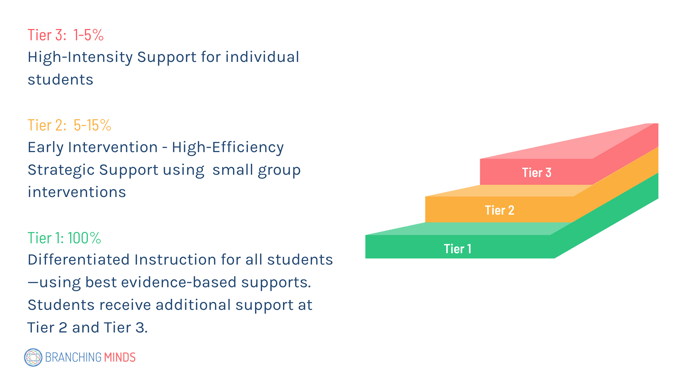
Progress Monitoring utilizes reliable and valid tools to assess performance, drive instruction, and evaluate the effectiveness of instruction and intervention supports.
Data-Based Decision-Making involves data analysis and problem-solving through collaboration among site-based teams to make decisions about instruction, interventions, implementation, and identification of SPED supports.
What Is the Science of Reading (SoR)?
According to Dr. Louisa Moats, a nationally recognized authority and co-developer of LETRS professional development,
“The science of reading is not an ideology, a philosophy, a political agenda, a one-size-fits-all approach, a program of instruction, nor a specific component of instruction. It is the emerging consensus from many related disciplines, based on literally thousands of studies, supported by hundreds of millions of research dollars, conducted across the world in many languages. These studies have revealed a great deal about how we learn to read, what goes wrong when students don’t learn, and what kind of instruction is most likely to work the best for the most students.”
The science of reading stems from over 40 years of research and centers around five key components:
- Phonemic awareness is the ability to identify and manipulate phonemes into spoken words and the sounds of spoken language work together to make words.
- Phonics is the understanding that there is a predictable relationship between phonemes (the sounds of spoken language) and graphemes (the letters and spellings that represent those sounds in written language).
- Vocabulary is the body of words used to communicate effectively. Vocabulary development has a primary role in reading development in supporting and increasing reading comprehension. Readers cannot understand the content of what they are reading unless they understand the meaning of the majority of words in the text.
- Fluency directly impacts reading comprehension. It is the ability to read words accurately and quickly. Reading fluency is a critical factor necessary for reading comprehension. If students read with speed, accuracy, and proper expression, they are more likely to comprehend the material efficiently.
- Reading comprehension is the culmination of all of the reading skills and the ultimate goal of learning to read. Comprehension is the complex cognitive process that students need to understand what they have read.
When teachers understand the essential skills for successful reading, they can parlay this knowledge into improved instructional practices, leading to student growth. Learn more about the research behind the Science of Reading along with effective practices HERE.
But, for some students, social, emotional, or behavioral challenges prevent them from accessing reading instruction in the first place. No matter how well the reading curriculum is designed and delivered, these students need behavioral support to set the stage for learning and make progress possible. In fact, all students benefit from intentional efforts to create a warm, supportive learning environment in which expectations are clear and problems are addressed proactively and positively. This brings us to the final piece of this puzzle in teaching reading, PBIS.
What Is PBIS?
Positive Behavior Interventions and Supports (PBIS) is an approach that also uses tiered, evidence-based supports, with a focus on proactively promoting appropriate behavior and a safe school environment for all.
PBIS encourages a learning climate/culture where all staff members are teaching, modeling, and reinforcing positive behaviors, not just using punitive methods to address students who are misbehaving.
- Tier 1 universal supports provide structure for all students. Clearly taught expectations in the classroom and for each activity and transition ensure that students understand why and how to behave as a scholar. There is a focus on building relationships with students and meeting their basic needs for safety and belonging, increasing the likelihood that students are ready for learning.
- Tier 2 behavioral interventions provide targeted support to small groups of students who need extra help with behavior. These interventions provide additional structure, feedback, and reinforcement for positive behavior.
- Tier 3 behavioral supports are individualized and focus on very challenging student-specific behaviors. Students with highly disruptive or dangerous behaviors typically require expert assistance beyond the classroom teacher, with intensive instruction and data collection.
How Does MTSS Connect With the Science of Reading (SoR) and PBIS?
MTSS is an umbrella that encompasses both academic and social or behavioral instruction, seeing them as intimately connected and important for the health and well-being of the whole child.
Students who experience low success in reading may exhibit inappropriate behaviors in the classroom setting by “acting out” or develop anxiety and negative feelings about school. Likewise, a student with social or behavioral challenges may not have access to core reading instruction due to their behavior, resulting in the student falling further and further behind. Rather than treating academic and social/behavioral skills separately, an MTSS approach addresses these needs in tandem.
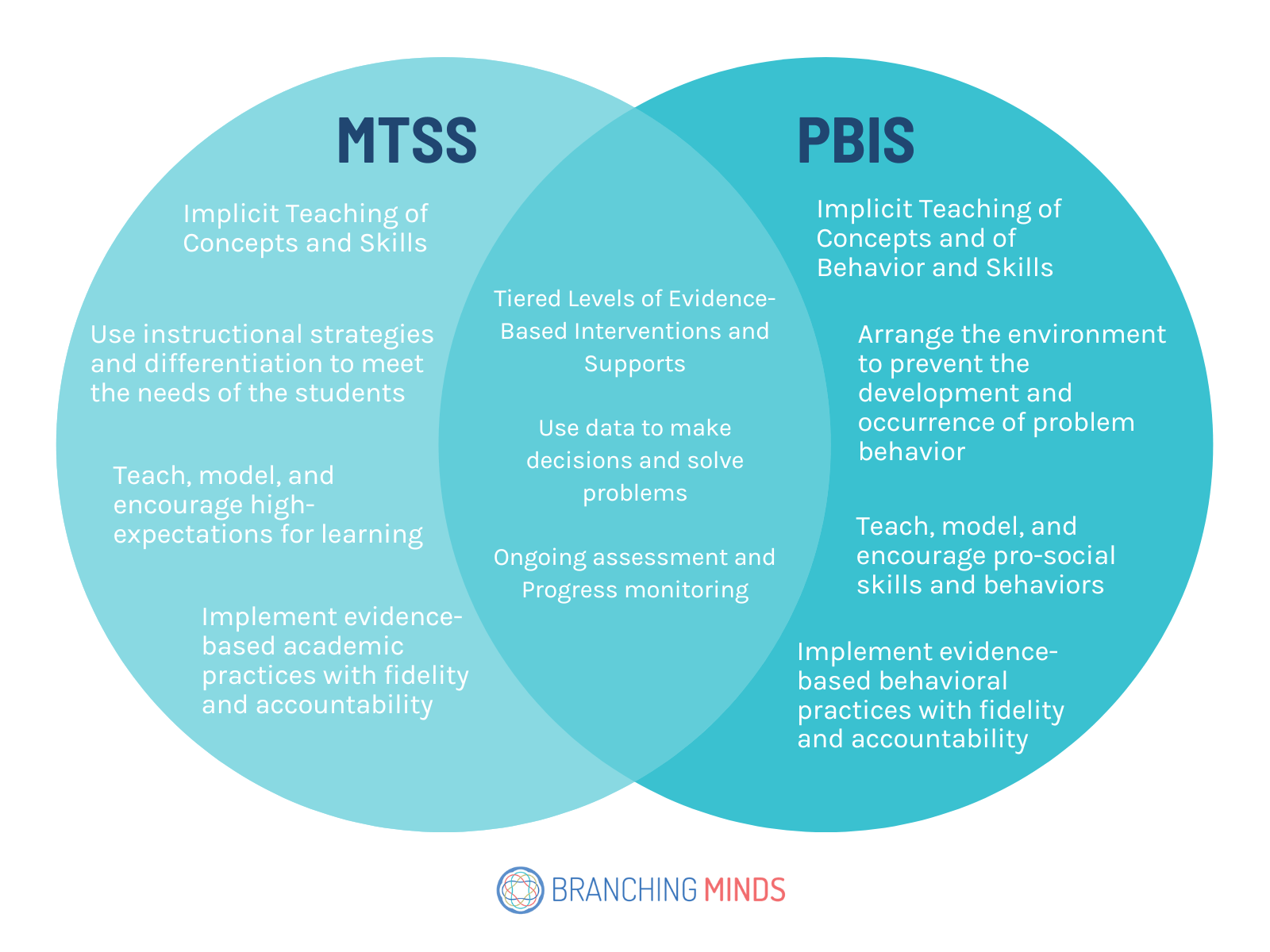
Tier 1 core instruction in academics (perhaps especially in reading) and in social/behavioral skills may be the most important part of the MTSS model because when teachers do this universal teaching well, only students truly in need of evidence-based Tier 2 or Tier 3 interventions will be flagged for additional support. Schools can focus their intervention time and resources on the students that need it, rather than trying to address core instructional deficits student by student.
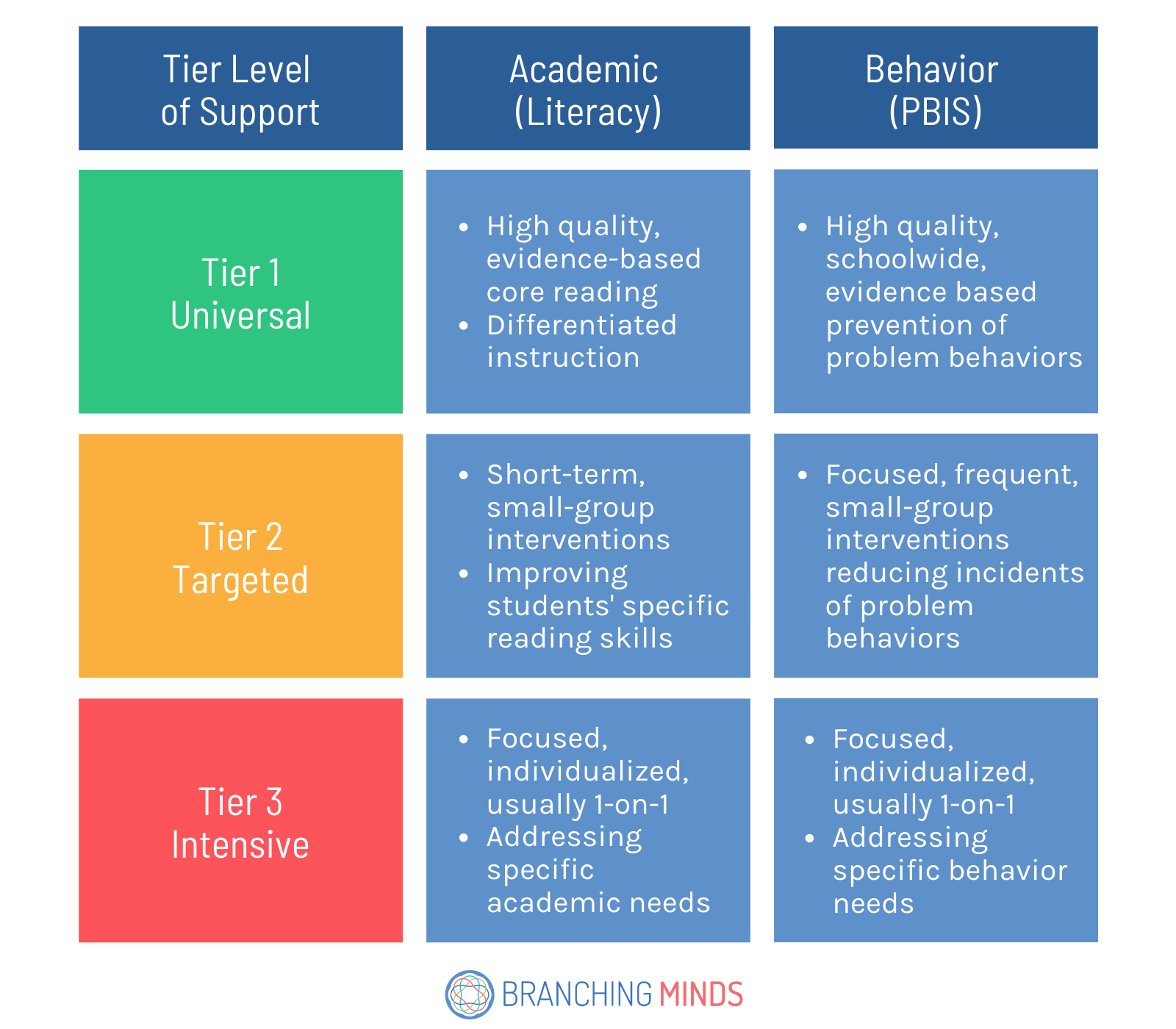
So let’s connect the dots…
In order for high-quality instruction to occur, educational programs must use:
- A standards-based core curriculum to explicitly teach skills from the Science of Reading five components.
- Evidence-based instructional practices and interventions for both reading and behavior that are implemented with fidelity.
- High-quality professional development with consistent training, coaching, and continuous support from administrators.
- Ongoing assessment and data to make informed decisions through problem-solving.
Using the MTSS framework with the Science of Reading (SoR) approach and PBIS structure provides the support needed for “the whole child” to experience success in school.
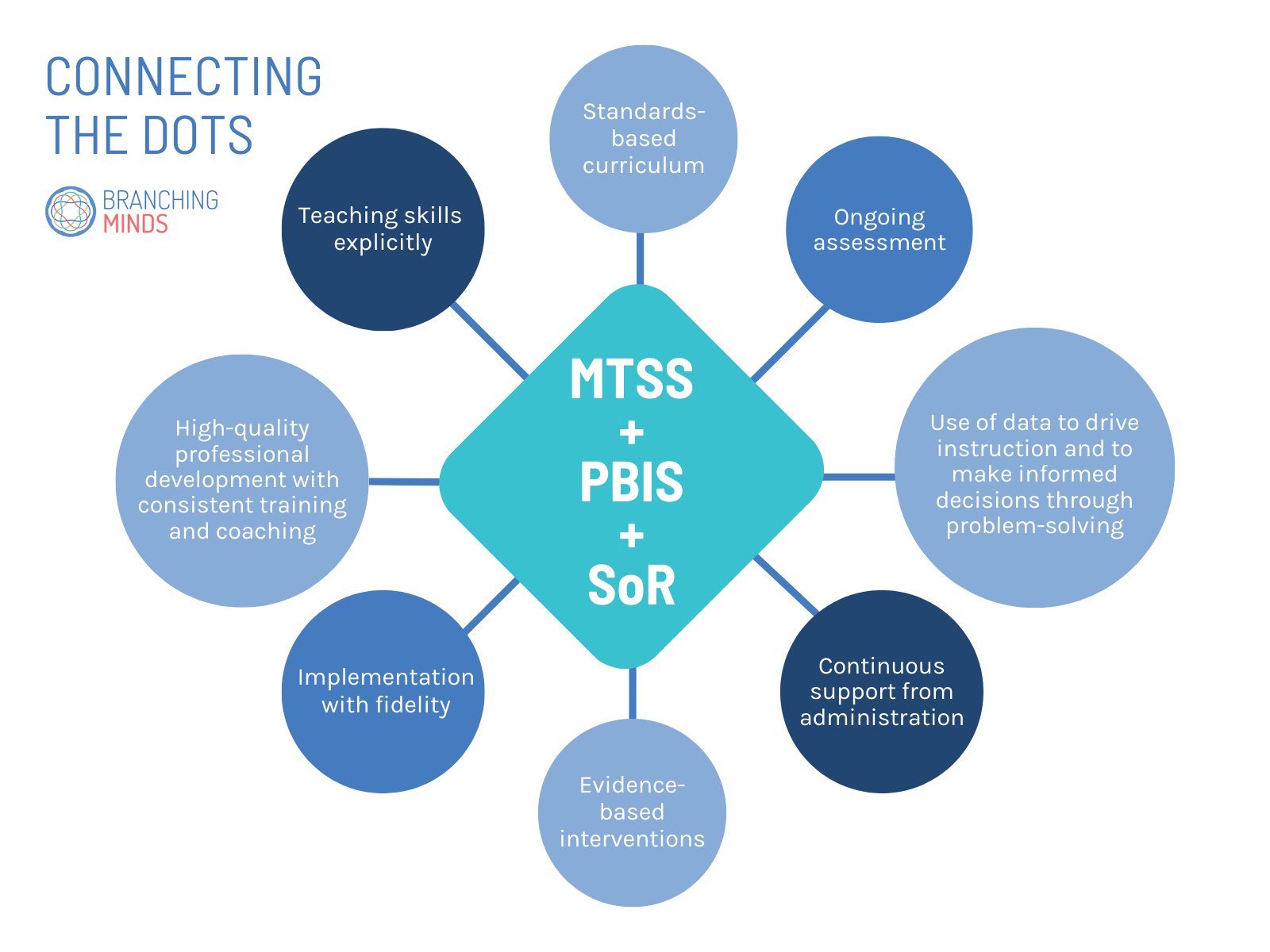
Supporting Students To Be Successful Readers: An Educator’s Pursuit
When students are quickly identified, given the appropriate interventions to match specific areas of need, progress monitored, and tools are provided to support focus and behavior, the connection between MTSS, the Science of Reading, and PBIS becomes clear. Now that we have the research-based instructional tools to help all students learn to read, we must ensure we continue to have an open mind when training and growing in our craft.
As educators, we welcome all of our students with the realization that we have no control over the specific areas of need of the students we teach. However, we have all the control over what we give to support them in reaching their goals of being successful readers and human beings.
|
Further your learning with these resources:
|
|
|
Make MTSS Easy, Efficient, and Effective With the Branching Minds Web Platform
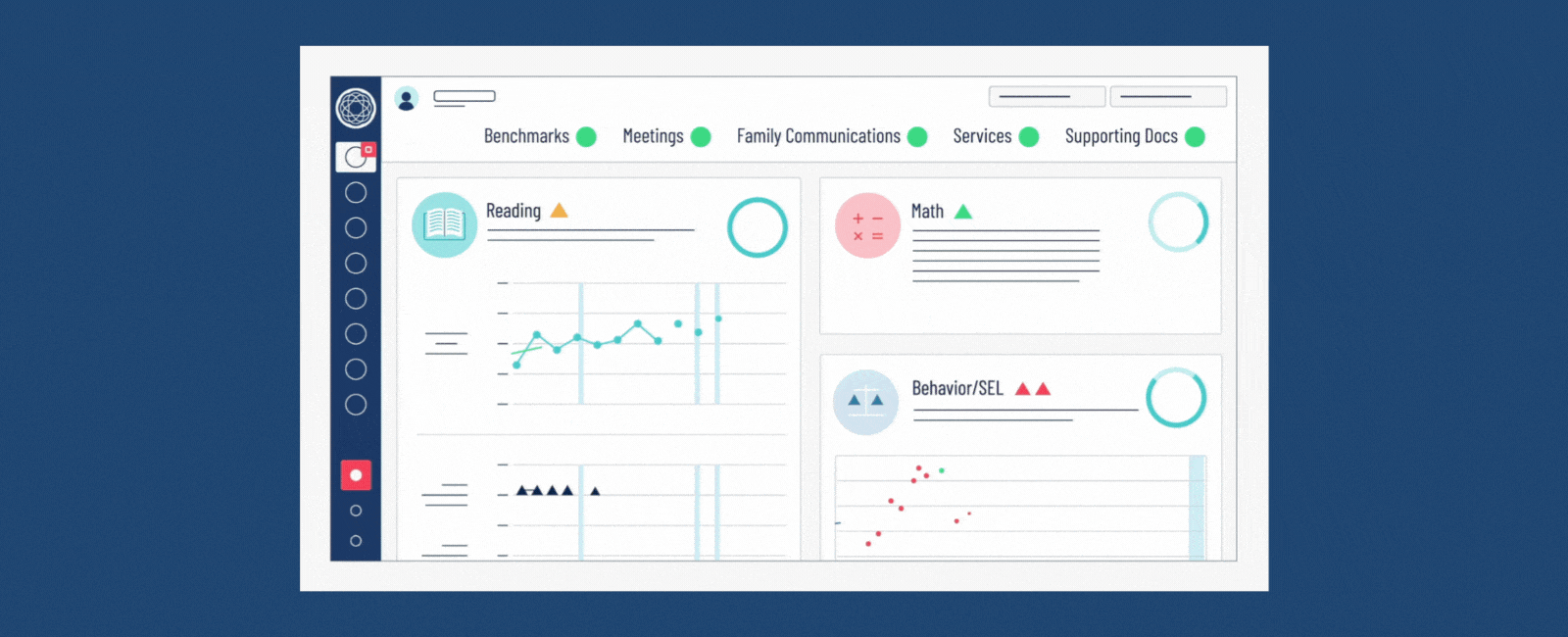
Transform your district's MTSS solution with personalized intervention plans, powerful collaboration tools, and easy-to-understand reporting. We are more than just a platform, we are a system-level partner.
Request a demo
|
|
Sources
Moats, L. (Summer 2020). Teaching Reading is Rocket Science. American Educator https://www.aft.org/ae/summer2020/moats
Montgomery, P., Ilk, M., Moats, L. (2013) A Principal’s Primer for Raising Reading Achievement, Cambium Learning
Shanahan, T. (2005). The National Reading Panel Report-Practical Advice for Teachers, ERIC. https://files.eric.ed.gov/fulltext/ED489535.pdf
Stewart, L. The Science of Reading: Evidence for a New Era of Reading Instruction. https://www.zaner-bloser.com/research/the-science-of-reading-evidence-for-a-new-era-of-reading-instruction.php
Comments (0)